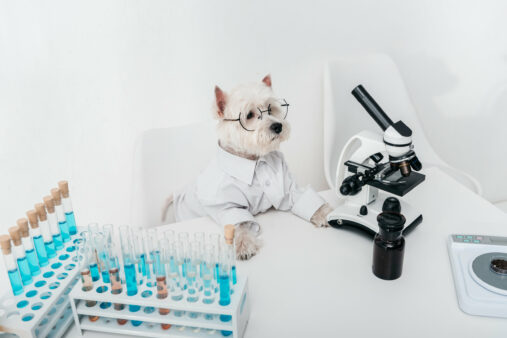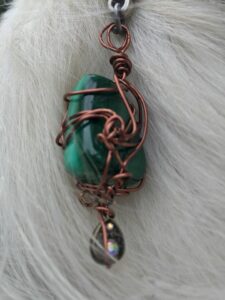Does the pH Level of Your Dog’s Shampoo Matter?
The pH (acid-alkaline) level of your dog’s shampoo matters, along with synthetic fragrances and harmful chemicals. Choose an unscented, mildly alkaline (7-7.5) shampoo to prevent hot spots, inflammation and skin damage. Avoid cleaning products like vinegar, most baby shampoos, Castille soap, dish detergents and shampoos designed for humans.
What’s pH? What are acid and alkaline levels? How do shampoos that are too acidic or too alkaline affect your dog’s health? Is pH more important that synthetic chemicals and fragrances found in many shampoos?
Although we’re not in chemistry class, if you’ve ever bathed a dog, you could be unwittingly engaging in a bit of a lab experiment (Lab, get it?).
In our article about the best and worst shampoos for dogs, we learned about the unique role of dogs’ fur and skin, common shampoo ingredients, fragrances, essential oils and health conditions that are impacted by shampoo. In this article, we introduce you to the role of pH levels in shampoos.
What is pH?
The “H” in pH stands for hydrogen, but the jury is out on exactly what the “p” stands for – it’s generally accepted that it refers to the “power” of hydrogen – and it’s powerful!
pH levels tell us about the chemistry of a substance, specifically how acidic, neutral or alkaline a substance is. The pH scale ranges from zero to fourteen with seven being neutral (the pH of pure water). The lower the number, the more acidic the substance. The higher the number, the more alkaline a substance is.
What Does pH Have to Do With Dog Shampoos?
Skin and body fluids, water, chemicals and shampoos all have a pH value that help them work best.

For example, if you have a swimming pool, you test the pH regularly to keep it within a certain level that’s “healthy” to swim in. If it goes too acidic, the water can corrode pool equipment and irritate skin, eyes and noses. Let your pool go too alkaline, and you get cloudy water that eats away at bathing suits and creates room for bacteria and algae.
Products that are too acidic or too alkaline can also do damage to the skin. A product that has a pH level which is too different from skin can cause inflammation or burns, and leave damaged skin open to bacterial infections.
Although it is generally agreed that canine skin is more alkaline (higher pH level) than human skin, there is no single agreed upon pH number or specific range. A confusing array of studies can have you spinning about pH levels.

Research suggests that pH levels of dog’s skin range from 5.5-9.1, however the majority of dogs are around 7.0-7.5. This is alkaline, compared with pH level of human shampoo, who average around 5.2 – 5.5. How do we explain such a broad range of pH levels among dogs? Studies have suggested that pH levels may depend on:
- breed
- gender
- time of day
- intact versus neutered status
- level of excitement
Diet and pH
pH levels rely on sufficient minerals and enzymes to buffer pH levels, and we typically obtain these from the soil our food is grown in. Sadly, the condition of our soil has dramatically decreased over the past several decades and we (and our dogs) are often deficient. Studies tell us that diet can affect pH levels in the urine, stomach, blood and cells. In severe cases, mineral deficiencies can affect the pH balance of bones, cellular metabolism and to some degree, skin integrity. A diet with insufficient nutrients can lead to bone fractures, kidney infections, liver and digestive problems, skin conditions, weakness, degenerative diseases and cancer (Schwalfenberg, 2011; Knight & Leitsberger, 2016).
In dogs, nutritional research supports a high fat, raw diet for optimal skin cell health, immunity and optimal genetic expression (Mohajeri et al, 2014). Highly processed, low quality “food” such as kibble is too acidic for optimal health and often begins with sick and rotting, genetically modified meats and fillers, with synthetic vitamins and flavour added to meet minimum legislated requirements.
The bottom line is that skin pH is indirectly affected by diet, but your dog’s overall health relies on a whole, fresh foods diet with sufficient clean meats, healthy fats and raw vegetables.
pH and Skin Infections
We know that certain yeast and bacterial infections thrive in specific pH ranges (4.0-8.0), so altering the skin’s pH through the therapeutic use of some acidic products (like vinegar) could inhibit growth, if used safely. Research also suggests that some skin infections grow more or less rapidly depending on the pH of the skin. This is important with dogs who are prone to skin infections like hot spots. Treating a topical skin infection to alter pH is one option in a holistic health care plan to boost your dog’s overall health and immunity.
What Is the Best pH Level for Dog Shampoo?
In most cases, you want to keep your dog’s shampoo around 7 -7.5. You also want to avoid toxic chemicals, synthetic fragrances and pH levels that are too acidic or too alkaline for puppies and dogs.
When it comes to choosing a shampoo for your dog, we’ve done the work for you! Healing Fur Souls gives you the bottom line on the best and the worst shampoo products for bathing your Fur Baby.
We get many questions about various products to use with dirty dogs – from dish detergent, to baby shampoo, vinegar and human shampoo. We’ve listed some common products and their pH levels below. Remember, in addition to safe, non-toxic ingredients, stick with shampoo that has a pH level around 7.0
pH Values of Common Shampoos & Cleansing Products
| Product | pH Level |
| Vinegar | 2.2 |
| Professional Hair Salon Shampoos | <5.5 |
| Johnson & Johnson Baby Shampoo | 5.5 |
| Burt’s Bees Baby Bee | 5.5 |
| Human dandruff shampoos | >5.5 |
| Average Human Shampoo | 5.84 |
| Average Pet Shampoo | 6.46 |
| Pure water | 7.0 |
| Burt’s Bees Shampoo for Dogs | 7.5 |
| Baking Soda | 8.3 |
| Dawn Dish Soap | 9.0 |
| Castille soap | 9.0 |
| Ivory Dish Soap | 9.5 |
A frequently referenced study by Bird (2011) showed that the average pH of 60 pet shampoos tested was 6.46, compared with the average pH of human shampoo (5.84). Although this is closer to recommended pH levels (around 7.3) only one third of tested pet shampoos were in this range.
Bird suggests that more manufacturers are getting in the pet product business, and are formulating dog shampoos and conditioners more closely to human products, to meet desired standards of hair.
Is adding more chemicals, changing the pH, using lighteners, brighteners, softeners and fragrances the best way to go? Where it comes to our precious Fur Souls, maybe we should keep things simple.
“For regular bathing, use a slightly alkaline shampoo. Only use acidic products occasionally for specific therapeutic purposes.”
Bottom Line About pH and Dog Shampoos
Overall, research suggests dogs’ skin is somewhat more alkaline as compared with humans, so products close to their natural pH levels are appropriate.
Here’s what we recommend:
- use a shampoo formulated for dogs (or puppies) that is fragrance-free and has minimal chemicals
- avoid human shampoo
- baby shampoo can be used in a pinch, but avoid synthetic fragrances
- shampoo or cleansing products (like vinegar) that are acidic should only be used for therapeutic purposes like certain skin infections (and under the guidance of a holistic vet or pet specialist) feed your dog a whole foods, natural diet with healthy fats, clean raw meats and vegetables that support healthy skin and fur
- view the list of the best shampoos for dogs you can use safely
- don’t over-bathe your dog
These steps will go a long way – perhaps even further than basing your shampoo decisions simply on pH.
Frequently Asked Questions (FAQ)
What is a safe pH level for dog shampoo?
For regular bathing, use a slightly alkaline shampoo of around 7 or slightly higher. Click here See our list of best dog shampoo’s
Which shampoo has pH balance?
Balancing pH levels is a complex chemical process and should be done in a lab – not a shower. Stick with using a shampoo that has a neutral pH or is slightly alkaline, as this is the most appropriate for most dogs’ skin.
What is a dog’s pH level?
It’s generally agreed that canine skin is more alkaline (higher pH level) than human skin. Some experts suggest dogs’ skin has a pH around 7.3-7.9, but this can vary.
Are dog shampoo pH levels different from human shampoo?
Yes. Human shampoo is formulated with different pH levels for different types of hair, and is typically more acidic. It also has fragrance, chemicals and colours that shouldn’t be used with your tender fur soul. Although pH plays a role, pay attention to ingredients and choose shampoos that have no fragrance, colour, and minimal chemicals.
Be kind to all beings. Respect the earth we share.
Links Seen in This Article:
- In our article about the best and worst shampoos for dogs, we learned about the unique role of dogs’ fur and skin
- This is important with dogs who are prone to skin infections like hot spots.
- Healing Fur Souls gives you the bottom line on the best and the worst shampoo products for bathing your Fur Baby.
- (and under the guidance of a holistic vet or pet specialist) feed your dog a whole foods, natural diet with healthy fats,
- view the list of the best shampoos for dogs you can use safely
References
Bird, B. (2011). A study of the pH of pet and human shampoos: mythology of shampoo pH.
Carter, J. (2019). Alkaline diets: what does that mean and why does pH matter so much to your pet’s health? volharddognutrition.com
Knight, A. & M. Leitsberger (2016). Vegetarian versus meat-based diets for companion animals. Animals.6(9), 57.
Mojaheri, S. et al (2014). Review of evidence for dietary influences on atopic dermatitis. Skin Therapy Lett. 19:5-7.
Schwalfenberg, G. (2011). The alkaline diet: Is there evidence that an alkaline pH diet benefits health?J Environ Public Health
Certain images and/or photos on this page are the copyrighted property of 123RF.com, its contributors or its licensed partners and are being used with permission under the relevant license. These images and/or photos may not be copied or downloaded without permission from 123RF.com







